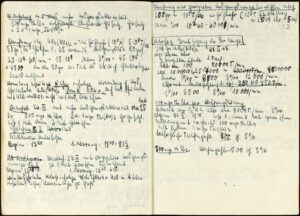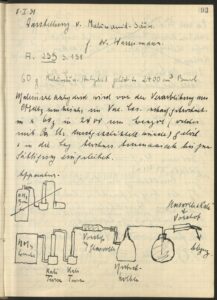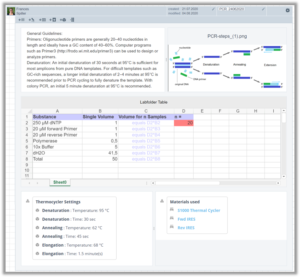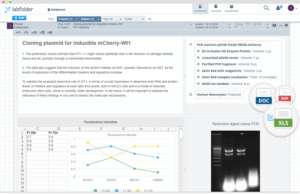What Is an ELN?

An Electronic Laboratory Notebook (ELN) is a system for documenting research work. The focus is on documenting the planning, execution and evaluation of scientific experiments. A central aspect is the joint work with several people and the networking of scientific equipment. At the same time, loss-free data transfer should also be ensured and should lead to uncomplicated merging of different measurement data. Thus, an ELN helps to document of experimental procedures like sample preparation, instrument settings, calibration, quality control etc.
Disadvantages of Paper-Based Laboratory Books

An electronic laboratory notebook is intended to replace a handwritten or printed laboratory notebook. Traditionally-historically, laboratory notes were made on paper, which has several disadvantages:
- It is less possible to include information already present in digital form, namely most output of scientific instruments (all that can be done, and is done is paste/glue printouts).
- Your handwriting may be(come) illegible for others, or even for your future self.
- Paper notes cannot be accessed remotely.
- Major projects may require a series of lab books.
- Paper notes are not automatically searchable, thus retrieving details well after an experiment was conducted may be tedious and time-consuming – if at all possible.
- Paper notes cannot be easily edited – no options such as Copy, Paste, Delete or Insert (text).
- It is not possible to create and use templates for recurrent processes.
- Paper notes have limited if any options for contributions by multiple group members.
To compensate for these disadvantages and to cope with the increasing digitalisation of research, more and more electronic lab books are now being used.
ELNs to Ensure Good Scientific Practice

An ELN can be very helpful in the good scientific practice for documenting research work. Follwing the Rules of Good Scientific Practice of the Max Planck Society, scientific examinations, experiments and numerical calculations can only be reproduced or reconstructed if all the important steps are comprehensible. By using an ELN, you can ensure that all relevant steps on the way to your research goal are documented.
Unfortunately, there are no open standards (yet) for lab books. There are many commercial providers for ELNs, open standards that would ensure that the content of each ELN can be effortlessly and cheaply transferred between ELNs is missing. This constellation entails that the data deposited in such ELNs become a kind of lock-in and do not apply the FAIR principles. This general issue should be taken into account when selecting an ELN. One way to address this can be to choose an open source solution.
ELN Solutions

There is not the one perfect ELN solution. Electronic laboratory notebooks offer far more flexibility, structure to data and digital preservation potential. Various ELN solutions have different features that may be particularly suitable for certain scientific fields or analytical methods. There are many systems on the market, so there is a lot of choice. The Harvard Medical School, the University of Cambridge and the ELN-Finder at the TU Darmstadt give an overview on the different ELN systems with their special features. MPDL can make suggestions after discussing your specific needs; for this please make use of our RDM-Support.
Labfolder is an ELN solution by Labforward GmbH licensed for all Max Planck researchers and their project partners. The registration for Max Planck researcher is free. For creating an Labfolder account your computer has to be part of the Max Planck network. Once you have signed up you can login to labfolder from all over the world.

Three main mailing lists within the MPG exist for ELNs: First, the general aspects of ELNs can be discussed at a ELN-list. Second, a MPG-internal mailinglist regarding ELNs exists. And third, there is a Labfolder-Info-list, specifically for Labfolder and its users.
Further Reading
B. Adam et al. (2023): Raus aus dem Kladdenchaos: Elektronische Laborbücher als zentrale Dienstleistung – Erfahrungen und Empfehlungen, In: Bausteine Forschungsdatenmanagement, (5), pp. 2–19. https://doi.org/10.17192/bfdm.2023.5.8553.
Brown, C. (2017). Electronic Lab Notebooks: Solutions for Paperless Research. Research Infrastructure and Data. https://researchdata.jiscinvolve.org/wp/2017/01/18/eln/.
Cambridge University Library: Electronic Research Notebooks.
Directorate General for Research and Innovation of the European Commission et al. (2020): Electronic Laboratory Notebooks (ELNs) as key enablers of open science: open science monitor case study, Publications Office, doi:10.2777/07890.
Foster, E. D., Whipple, E. C. & Rios, G. R. (2022): Implementing an institution-wide electronic lab notebook initiative, In: Journal of the Medical Library Association, 110(2), doi:10.5195/jmla.2022.1407.
B. Gerlach, C. Untucht, and A. Stefan (2020): Electronic Lab Notebooks and Experimental Design Assistants, in: Good Research Practice in Non-Clinical Pharmacology and Biomedicine, A. Bespalov, M. C. Michel, and T. Steckler, Springer International Publishing, pp. 257–275, doi:10.1007/164_2019_287.
Y. V. Grossmann (2021): Survey Results on the Usage of Electronic Laboratory Notebooks in the Max Planck Society 2021, http://hdl.handle.net/21.11116/0000-0008-F071-9.
Harvard Longwood Medical Area Research Data Management Working Group (2021): Electronic Lab Notebook Comparison Matrix, https://doi.org/10.5281/zenodo.4723753.
Higgins, S. G., Nogiwa-Valdez, A. A. & Stevens, M. M. (2022): Considerations for implementing electronic laboratory notebooks in an academic research environment. Nature Protocols, 17(2), 179–189, https://doi.org/10.1038/s41596-021-00645-8.
S. Kanza et al (2017): „Electronic lab notebooks: can they replace paper?“ Journal of Cheminformatics, vol. 9/1, May 2017, p. 31. BioMed Central, doi:10.1186/s13321-017-0221-3.
M. Kihlén and M. Waligorski (2003): “Electronic Lab Notebooks – A Crossroads Is Passed“, Drug Discovery Today, vol. 8/22, pp. 1007-09, doi:10.5062/F4TX3CMM.
R. Kwok (2018): “How to Pick an Electronic Laboratory Notebook“, Nature 560/7717, August 2018, pp. 269–70, doi:10.1038/d41586-018-05895-3.
OECD’s Work on Good Laboratory Practice (GLP).
ZB MED-Informationszentrum Lebenswissenschaften (2021): ELN Guide: Electronic laboratory notebooks in the context of research data management and good research practice – a guide for the life sciences, doi:10.4126/FRL01-006425772.
Latest News about ELNs
- MPG Internal Key User Workshop on Labfolder

- Slides and Videos from the Workshop “Living with Electronic Laboratory Notebooks” are available

- Survey Results on the Usage of ELNs in the Max Planck Society 2021

- Preliminary Announcement ELN Workshop in September 2021

